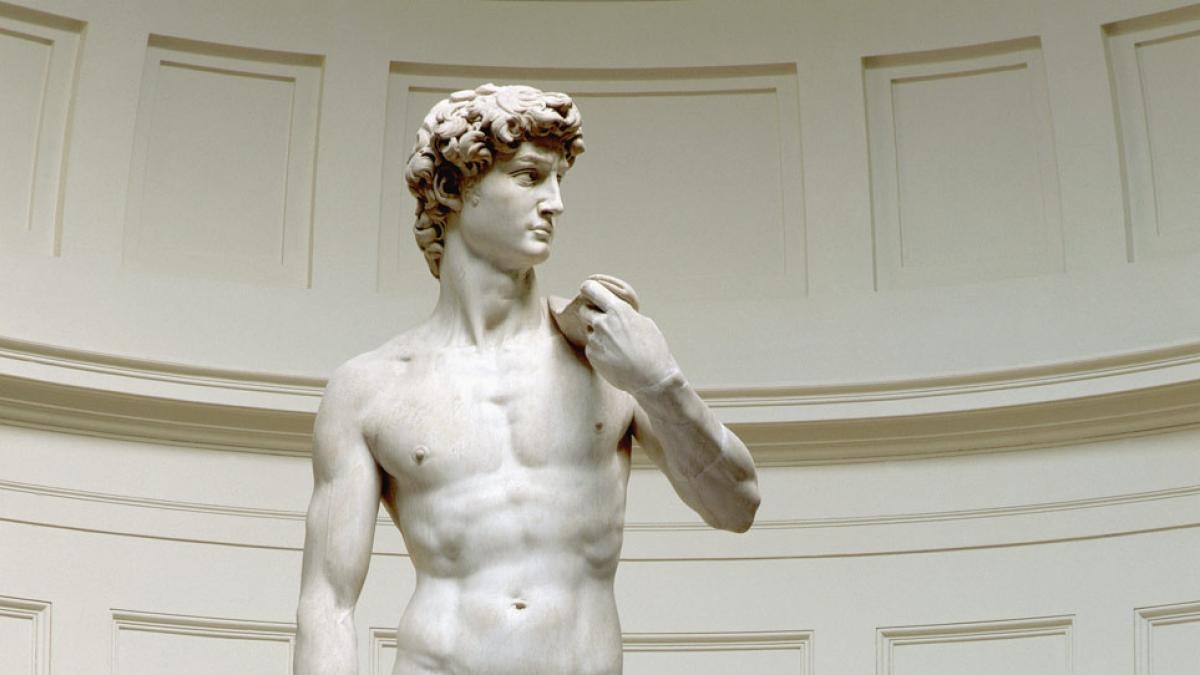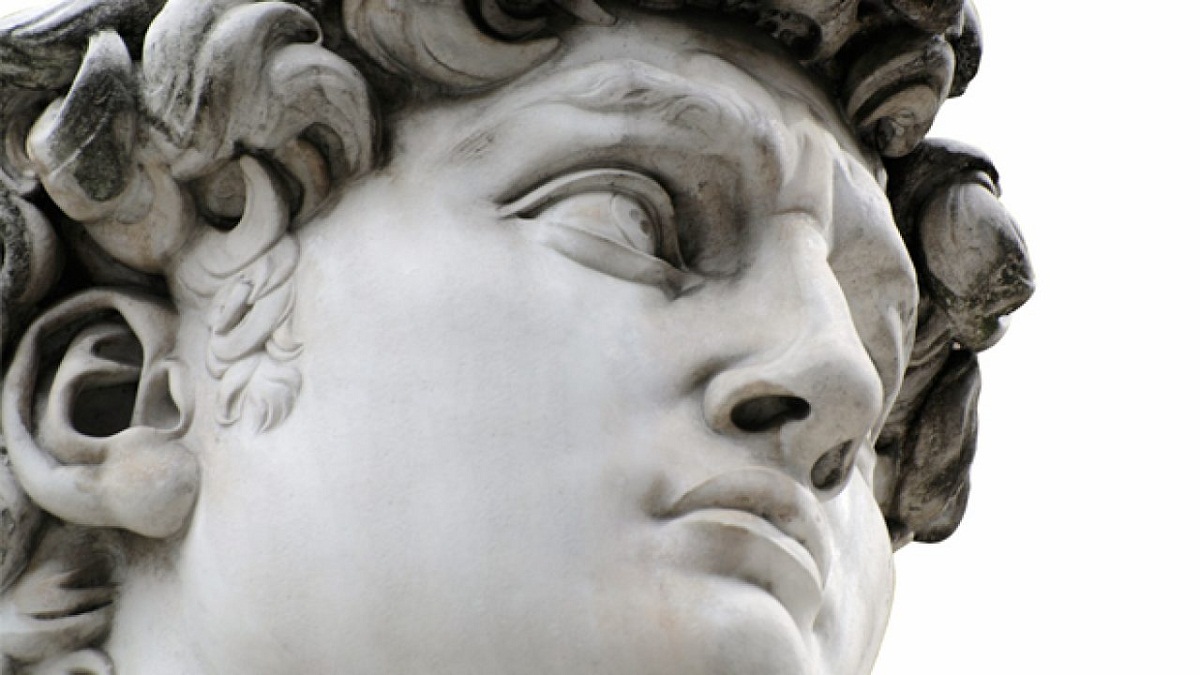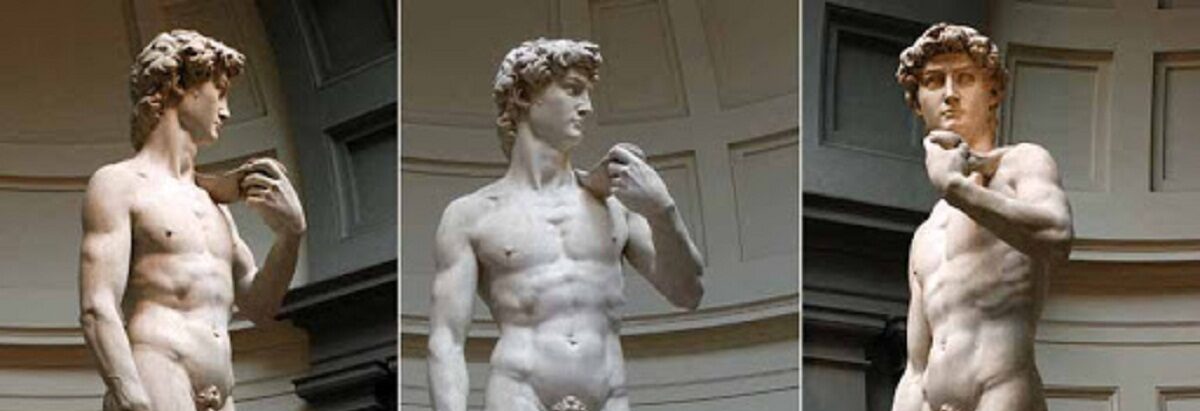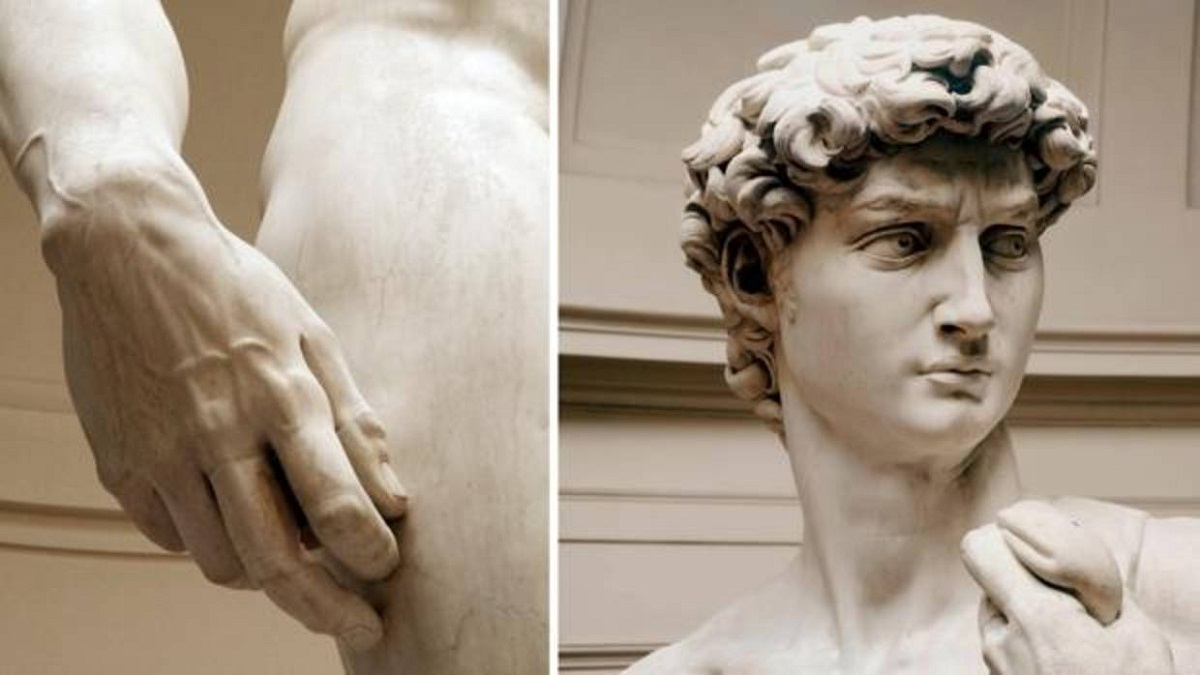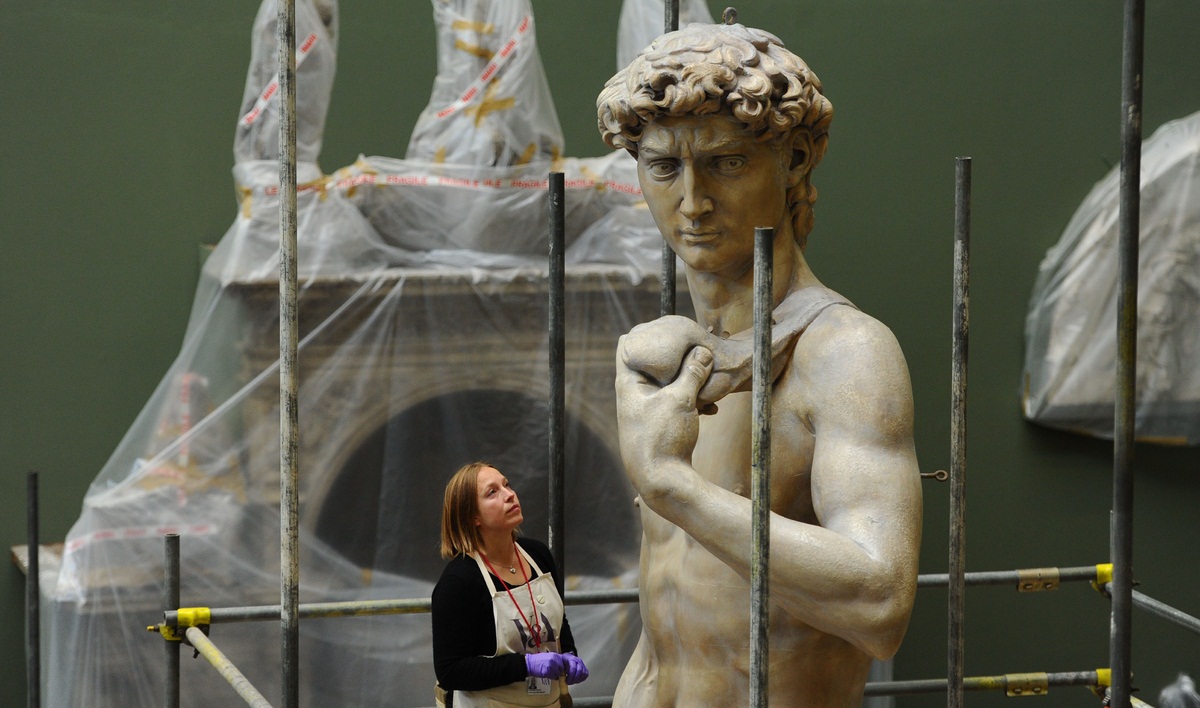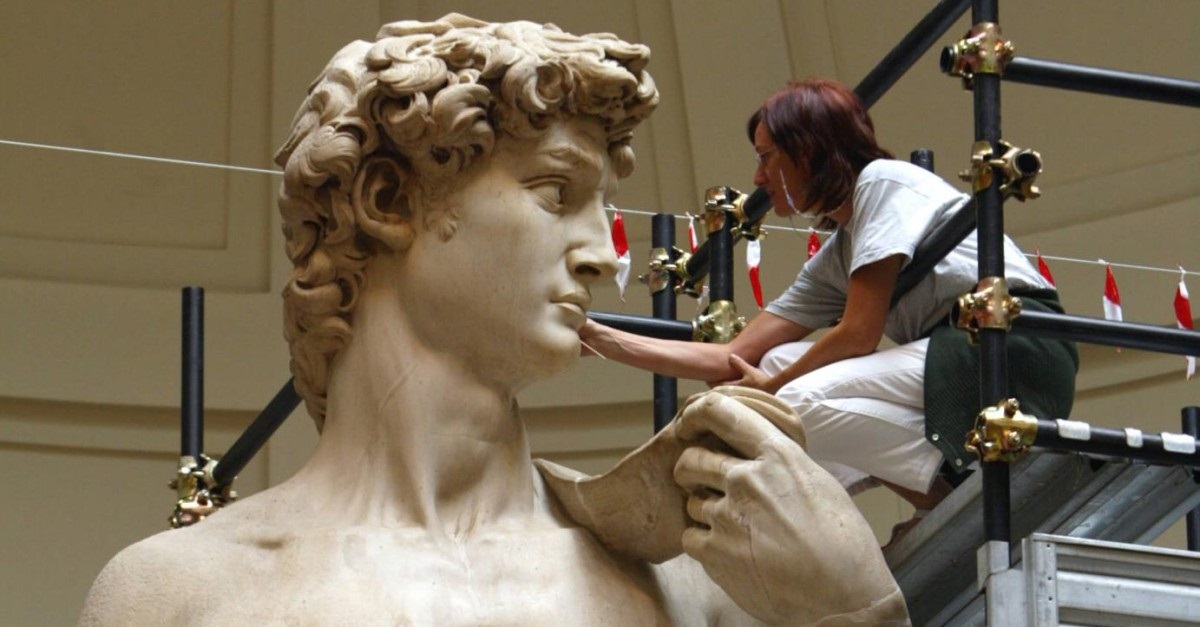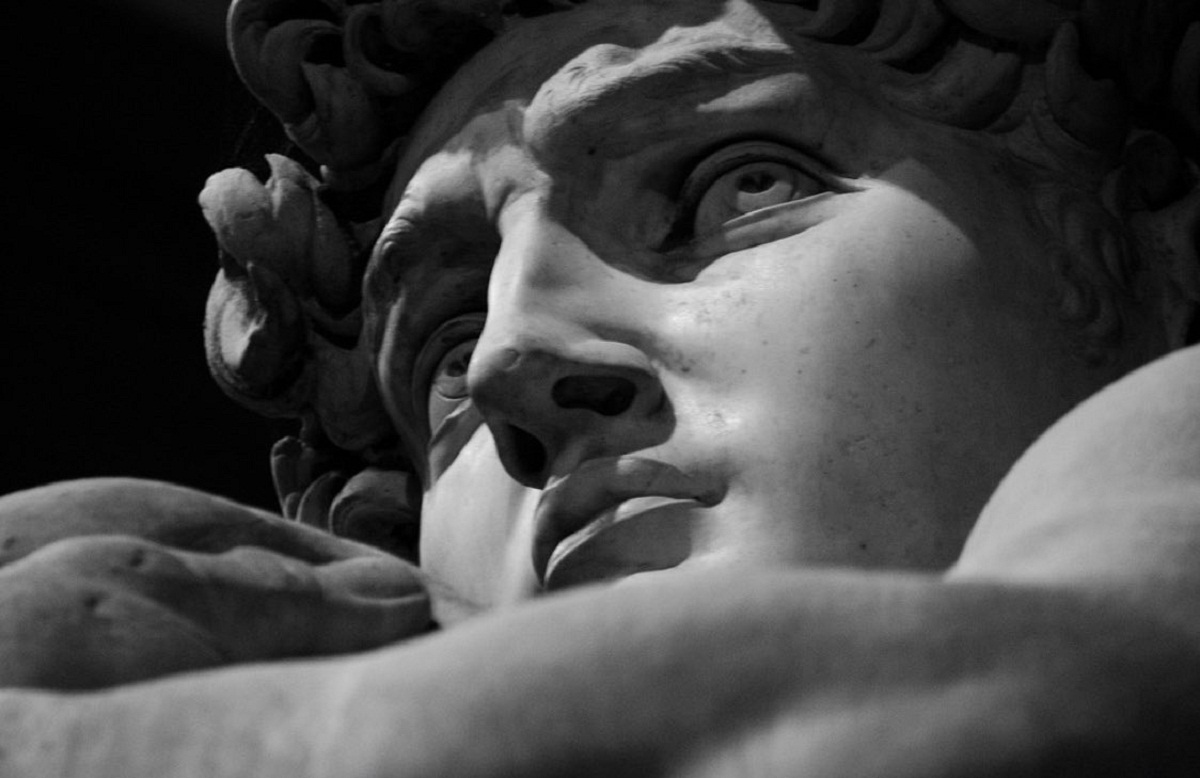Today we will teach you through this excellent post everything about sculpture the David by Michelangelo Florentine artist who devoted his attention to the human virtues of this biblical being that he made at the age of twenty-six and represents the young man before defeating the giant Goliath. Don't stop reading it!

Background of sculpture David by Michelangelo
By the year 1501, those in charge of the Opera del Duomo were a lay institution that was in charge of conserving and maintaining the real estate that belonged to the sacred temples.
For this reason, twelve large sculptures related to characters from the Old Testament were proposed for that date to be placed on the external buttresses of the Santa María del Fiore Cathedral.
Therefore, before creating the sculpture of David by Michelangelo, two sculptures had already been made, one of them by Donatello and the other by one of his disciples named Agostino di Duccio, receiving in 1464 another commission to make a sculpture of David .
You should know that the block of marble from which the sculpture of Michelangelo's David was created was extracted from the Fantiscritti quarry in the town of Carrara, this immense block had been transferred to Florence by the Mediterranean Sea and then by the Arno River until arriving to the Italian city.
This huge block known as the giant was damaged by an artist named Simone da Fiesole trying to carve it. Moreover, this block of marble was separated by those in charge of Santa María del Fiore and abandoned for years.
Other artists who also worked on this huge block were Agostino di Duccio as well as Antonio Rossellino but they did not achieve a work and left this huge block with several fractures and half worked.
So the authorities of the Opera del Duomo began looking for a sculptor to sculpt David and among them was Michelangelo after twenty-five years that Rosellino had abandoned work on this block of marble.
He began his work on sculpture on September 13, 1501, a month after the order of the commission until May 1504, he was still a young artist who was not yet thirty years old and he produced the most beautiful work known. in the world.
Although the theme of David had already been worked on by other sculptor artists such as Ghiberti, Verrocchio and even Donatello, it was Michelangelo who took the moment before the fight in the sculpture.
Being the sculpture of David by Michelangelo the icon of the Italian Renaissance thanks to the human qualities that this Italian artist placed in the statue. It was commissioned by the Opera del Duomo and would be placed in the Cathedral of Santa Maria del Fiore in the city of Florence.
But due to the dimensions of the sculpture of David by Michelangelo, it seemed to them that this space was not suitable for the majestic work, so it was placed in the Piazza della Signora, a place that dazzled with its beauty and virtuosity.
It was on this site until the 1873th century, specifically in XNUMX. Today it is housed in the Galleria dell'Accademia in the city of Florence, Italy, being one of the most important museums in this Italian country.
It is important to highlight the threatening gaze of Michelangelo's David, which raised doubts about the place that would be its site, since if it was placed facing Pisa, it meant Florence's desire to recover this city.
If it was placed facing Rome, it brought inconveniences because Pope Alexander VI had sheltered the Medici after being expelled from Florence. It was this site that they decided as the birth of a new Republic of Florence and in the four days that the transfer lasted the sculpture was stoned by supporters of the Medici.
Analysis of the qualities of the sculpture David by Michelangelo
It is important to note that the sculpture David by Michelangelo is the representation of the biblical David who defeats Goliath through his cunning through a stone thanks to the power of God and thereby becomes King David.
According to the sculpture, Michelangelo's David represents him as a strong man standing upright to face the mighty Goliath, with his left hand resting on his shoulder where he carries the sling bag.
A harness that girds his back until it reaches his right hand near his thigh where he hides the fustibalo, which is the sling with a shaft that was common in Roman times.
Among its main qualities, it is evident that the David sculpture by Michelangelo is a Round bump because it can be seen from any angle thanks to the conception of the Italian sculptor.
This sculpture of David by Michelangelo is placed in a contrapposto which is the position of standing on one foot, thus supporting your entire body weight.
While the other leg is relaxed so the hips and shoulders are at different angles so David's torso has a minimal S-shaped curve.
Due to the contrapposto position is that the sculpture of David by Michelangelo has the balance because the tension that is observed between the left arm and the right leg allows a natural swing in the left leg and the right arm.
It is presented in the sculpture of David by Michelangelo the tension and relaxation simultaneously to allow the rest of the body and the alert position to face the giant Goliath.
Well, it is about keeping the body at rest for a possible action and in the sculpture the sculptor's knowledge of the male body is observed in order to harmonize the emotional coupled with the physical in the sculpture.
Another of the qualities of Michelangelo's David is his expressive face Well, the look of this sculpture is defiant, manifesting the great power it has against the enemy. As is the frown that is known by the term of terribilità.
Like his gaze that darts defiantly to the right under his flowing hair. Which is a great virtue in the Renaissance movement, self-confidence as well as perseverance and in the words of Michelangelo himself expresses the following:
“…In each block of marble I see a statue as clear as if it stood before me, in form and finish of attitude and action…”
“…I just have to carve out the rough walls that imprison the precious apparition to reveal the other eyes as I see them with mine…”
It also stands out in Michelangelo's David unequal proportions in the statue but that at first glance seem unnoticed but the right hand and the neck attached to the head of the statue is of greater proportion.
You can see that the right hand that rests relaxed next to the thigh is delicately sculpted, denoting the veins and marks on the skin, but when measured with respect to the size of the body, it is observed that it is much larger.
Another of the qualities is the larger size of the sculpture's neck, which is thicker than the middle of the chest, but at a simple glance it is not noticeable.
Although this was done in Michelangelo's David intentionally because the visual effect was preponderant when looking at the sculpture from the bottom up.
Also to show that winning a battle required concentration and cunning which is symbolized by the head and the action is symbolized by the right hand.
It is also observed as a great quality the used material because it was a single block of white marble that was extracted from the quarry of the Carraca mountains that was recognized for its excellent quality.
It is essential to note that this same block of marble had the opportunity to be intervened by three artists for several years, which was the cause of fractures and perforations in the immense block.
Twenty-five years had passed and it is Michelangelo who, under the orders of the authorities of the Opera del Duomo, must make the David to be placed in the Cathedral of Florence and in the words of the sculptor himself, he pronounced the following:
“…When I came back, I found that he was famous. The city council asked me to take a colossal David out of a block of marble, damaged!, almost twenty feet after the creation of the Pietà…”
Meaning of Michelangelo's David
The cleverness of this great sculptor is to have thought of sculpting David before the confrontation with the great Goliath, which is why it was necessary to capture the action of the confrontation in that sculpture before it happened.
For what is observed in Michelangelo's David, intelligence before physical strength where mental concentration prevails to place all parts of the body in balance to defeat the opponent through human ingenuity and the power of divine wisdom.
It is a well-known story from the Old Testament where David defeats Goliath with a slingshot and then, lying on the ground, decapitates him with his own sword and at the historical moment of the city of Florence as an Independent State.
This nation was very aware of the threats that surrounded it, they saw this Michelangelo's David as the symbol of unexpected strength and unwavering courage thanks to the cunning and ingenuity of intelligence.
The union of philosophy with religion
Michelangelo manages to unite the symbol of David in the context of Judeo-Christian culture with the values of the Renaissance movement, which are balance and weighting, since for this he had to increase the human virtues of this sculpture.
So Michelangelo's David shows that it is not strength but intelligence as well as the consideration of action that raises his spirit for the confrontation with Goliath because he was committed to his people and had to save them with this battle.
Hence the importance of this David by Michelangelo for the Renaissance, since intelligence and virtue prevail over physical strength, demonstrating the values of humanism in this cultural context.
The political vision in Michelangelo's David
By the year 1494 the city of Florence had risen up against the Medici being its leader Pedro II de Medici who was the heir to Lorenzo the Magnificent and had capitulated in front of the French army of Charles VIII but these terms had outraged the inhabitants from the city of Florence.
For which they decided to expel the Medici from their city and create the Second Republic of Florence and when this immense sculpture was completed it was used as a symbol that demonstrated the human greatness of this city against the Medici and the Papal States.
Reaction to the Sculpture being presented
At the moment in which Michelangelo's David was presented in 1504 in the presence of the members of the sacristy who had commissioned the sculptor, they were amazed at the perfection that he had achieved, which is why they desisted from placing it in the cathedral as I thought at first.
With the intention of obtaining a new site to place the excellent sculpture of David by Michelangelo, they put together a committee made up of thirty renowned people, including Leonardo Da Vinci and Sandro Botticelli.
Due to this, Michelangelo's David was placed in the heart where political life took place in the city of Florence and this site was the Piazza della Signoria that was in front of the entrance of the Palazzo Vecchio.
This work of art remained there until 1873. Although it should be noted that in its place there is a copy of the statue in white marble which was placed in 1910.
Today Michelangelo's David is sheltered in the Accademia Gallery in the city of Florence, being the most important museum in this city after the Uffizi Gallery. After this success, Pope Gioulio II himself commissioned Michelangelo to build the Sistine Chapel.
Historical context for the time of the sculpture's creation
Since the year 1434 Cosme de' Medici had taken power in the city of Florence, for which he was known as the Signore of this city until the year 1494 four Signore had elapsed but in this year there was a rebellion.
Given that Signore Piero de Medici surrendered to the advance of the reign of Charles VIII of France to the reign of Naples. Because of this, one of the religious named Girolamo Savonarola used the discontent of the population to overthrow the Medici empire.
The annoying inhabitants took it upon themselves to loot the monarch's palace and the Republic of Florence was produced. This Republic of Florence would be governed by nine people who made up the new Republican Signoria, Savonarola himself being in charge of a persecution against vanity.
Making a bonfire in the Piazza della Signoria where objects that were considered sinful were burned as well as works of art by Michelangelo and Botticelli that they themselves were in charge of burning as well as people who were prosecuted as heretics.
Disputes took place between the religious Savonarola and Pope Alexander VI and on May 08, 1498, the cleric signed his confession and was executed on June 23 of that same year in Piazza della Signoria, the center of political power in the city.
artist's technique
In order to create Michelangelo's David, he required sketches, drawings and small-scale models made from the use of wax or terracotta.
From there he went directly to work with marble and using the chisel from various points of view so that the sculpture could be admired from any angle, which was totally new for medieval thought, which only allowed sculpture to be seen from the front.
It is important to highlight his great ingenuity, which allowed him to remove the work from that immense block of marble, being the first Renaissance statue of these proportions, creating a man with the wisdom and power of God, since man was created to the nature of the supreme being.
Sculpture style and details
According to Michelangelo's thought, in each block of marble in which he was in charge of designing, there was for him a soul that he tried to recover.
Therefore, in the case of Michelangelo's David, the fractures that this immense block had, in addition to the hole that existed on the left flank of the marble block.
It originated that the sculpture rested on the right foot, which generated the concept of contrapposto of the sculpture and Michelangelo's David had to balance to give balance to the statue.
Damage suffered by the sculpture and its restoration
By the year 1504, when Michelangelo's David was moved to Piazza della Signoria, the work was stoned by supporters of the Medici, then in 1512 lightning struck the base of the sculpture.
Then in 1527, in a popular rebellion against the Medici, Michelangelo's David had his left arm amputated after hitting him with a bench thrown from a nearby window. This arm was replaced after sixteen years.
Later, in 1843, Michelangelo's David was cleaned with a mixture of hydrochloric acid on the total surface of the sculpture and thus a protective patina that its author had placed on it was removed, due to which the marble was being left exposed to the climate.
After thirty years, specifically in 1873, the imposing figure was moved from Piazza della Signoria to the Accademia Gallery.
With the intention of protecting Michelangelo's David sculpture from the weather and avoiding unnecessary damage, in 1910 they decided to place a 1:1 scale copy of the statue in the place that the sculpture occupied in Piazza della Signoria and it still stands today.
It is said that in 1991 a man destroyed a toe of the left foot of Michelangelo's David after having hit it with a hammer, it was reconstructed.
To avoid future damage, the work was placed in an armored glass structure that surrounds the base where this enormous sculpture is placed on all sides.
Due to the fragments of the marble that remained after the attack to destroy one of the toes of his foot, the consistency could be studied to know that Michelangelo's David was built with marble.
It was found that it contained a large number of microscopic holes that allow a much faster degradation than in other kinds of marble.
It is in 2003 that the first restoration of Michelangelo's David began in 1843, which brought a great number of inconveniences due to the method to be used and the person in charge of that restoration was Agnese Parronchi.
But she had to resign due to discrepancies with the superintendent of Artistic Assets of the Tuscany region named Antonio Paolucci.
According to the Parronchi studies, she was determined to carry out a dry and non-invasive intervention in the sculpture of Michelangelo's David through brushes, erasers and cotton swabs.
But Paolucci and the director of the Gallery of the Academy named Franca Falletti, their idea was the wet intervention through compresses of distilled water applied to the sculpture for fifteen to twenty minutes.
Although the wet intervention was the restoration that was carried out on Michelangelo's David and was completed on April 22, 2004 under the direction of Cinzia Parnigoni and was presented to the public again on May 24, 2004.
Curious facts about Michelangelo's David
The interaction that Michelangelo carried out with the marble blocks is evident and he defined his hard work as a liberation of the figure that was inside the stone.
At the moment of starting to sculpt the David, he decided to have four walls erected around the block to avoid intruding glances at his work.
So it is not known how the sculpture was born and when he finished sculpting the work is when he orders the walls to be torn down and people are surprised to see the sculpture.
This work, which was of a Catholic nature, brought political actions as a consequence, since by the time of its inauguration they had already overthrown the Medici of the city of Florence.
The city became a republic and Michelangelo's David became an icon of freedom as in the biblical story that the young man protects his people.
There were also critics for the nudity of Michelangelo's David, to which they argued that nudity was harmony with nature demonstrating spiritual supremacy, virtue and the beauty of the male hero. Many were engrossed with the beauty of the work.
Well, he showed in Michelangelo's David great detail in the thighs, veins, nails, hair and look, his frown shows that he is thinking about how he is going to throw the stone with the slingshot to end the life of the giant Goliath the only thing What this majestic work lacks is talk.
After completing his majestic David, Michelangelo left for Rome where he had other commissions such as the frescoes in the Sistine Chapel and there in 1506 a statue was unearthed and Michelangelo, as an expert on the subject, went to see the statue.
He realized according to the descriptions that it was Laocoön, which was made up of five marble blocks, although the assembly was almost imperceptible to others, it was not to Michelangelo.
What perhaps for him was a victory because he was the only one who from an immense block of marble gave life to Michelangelo's David and that was a value of great preponderance for this excellent sculptor who was one of his great facets.
If you found this article interesting, I invite you to visit the following links:
